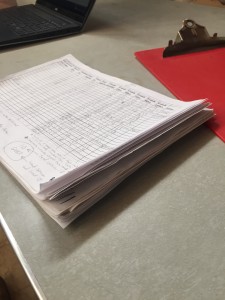Our final trial was finished on October 2nd. We had been collecting data for about four months, amassing a pile of data sheets. You can see some of them above. I spent a few days inputting all the data into excel a few weeks ago. Connor just sent me the preliminary graph as seen below that shows the preference of the different species we looked at. It is difficult to see the insect species names and plant species names in the picture so I will try to describe a bit of what it says. Gryllus is on the top right, Pterostichus is on the bottom right, Harpalus is on the bottom left, and Allonemobius is on the top left. As predicted in my previous post, Gryllus ate the majority of most species except velvetleaf and hairy vetch. Radish was also one of the least preferred (it also has a harder seed coat). One of most significant findings we found overall was Gryllus’ preference for red clover. They ate every red clover seed! The others they preferred most were pearl millet, triticale, giant foxtail, ragweed, winter barley and annual ryegrass.
The graph shows clearly that Pterostichus preferred pearl millet seeds to all others. If I had to guess based on all the counting I did I would’ve said Pterostichus preferred triticale and radish more than they apparently did in contrast to the millet. Millet was always their first choice though.
Harpalus seemed to favor the Giant Foxtail. This is important because, as I spoke of before, Giant Foxtail is a weed, it isn’t used as a cover. Perhaps Harpalus is ultimately beneficial (at least from an economic perspective) in an agro-ecosystem because of the suppression of that weed it offers. On the other hand it also has a particular taste for annual ryegrass, pearl millet, red clover, and white mustard. These are all commonly used cover crops that can have huge benefits on production over time. Harpalus’ potential benefit (or potential for harm) would depend on the agricultural system.
I haven’t spoken much about Allonemobius allardi. Maybe this is because until recently Connor was still debating which species of cricket this was. They are a smaller cricket than the Gryllus species we tested. We would spend hours sweeping nets across the tall grasses out behind the processing center looking for them. We caught hundreds. Interestingly they were the only species to prefer Ragweed more than the others. Ragweed is another one of the three plants that we tested that aren’t used as cover crops. They also preferred pearl millet, giant foxtail, and winter barley to the others.
These are preliminary results. Connor plans to do quite a bit more work with these numbers before they can be applied.
The final tasks have been cleaning petri dishes and recovering the traps from the field.
Thank You Connor, Matt, and the entire Sustainable Cropping Systems Lab!





